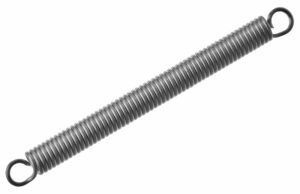
Ever wonder why extension springs have hooked ends? There are two primary types of springs: compression and extension. While they both consist of coiled metal, only extension springs have hooked ends.
As shown in the adjacent photo, the ends of an extension spring feature a partially closed loop. This hooked design is exclusive to extension springs. Compression springs are available in many of the same materials, including music wire and stainless steel, but they don’t have this same hooked design. Why do extension springs have hooked ends exactly?
Support for Tension Load
The hooked ends of extension springs allow them to support a tension load. Tension loads involve an axially pulling force. While compression springs support a compression load — a pushing force — extension springs support a tension load.
With hooked ends, an extension spring can connect two objects. As the objects pull away, the extension spring will become longer while simultaneously storing the mechanical energy of the tension load. Whether it’s made of music wire, stainless steel or any other metal, though, the extension spring must be able to connect the two objects, which is why extension springs have hooked ends.
Ease of Installation
There are other ways to connect springs to objects, but hooked ends are arguably the easiest solution. You don’t have to use any fasteners or tools. As long as the objects have fixed anchor points, you can connect an extension spring to them. The hooked ends offer secure attachment points, making installation a breeze.
Prevents Slippage
The hooked ends also prevent slippage. Extension springs must be directly and physically connected to the two objects. If they slip off one or both of the objects, they’ll no longer support the tension load.
With hooked ends, extension springs will remain attached to the two objects. The hooked ends will attach to the objects’ fixed anchor points, thereby preventing the extension springs from slipping.
Don’t Overlook the Gap
You should check the gap when shopping for extension springs. The gap represents the size of the opening on an extension spring’s hooked ends. While all extension springs have hooked ends, some of them have a larger gap or opening than others.
You’ll need to choose extension springs with a large enough gap to accommodate the objects with which you intend to use them. If the gap is too small, the hooked ends may not fit on the objects. With that said, an excessively large gap may result in a loose connection.
